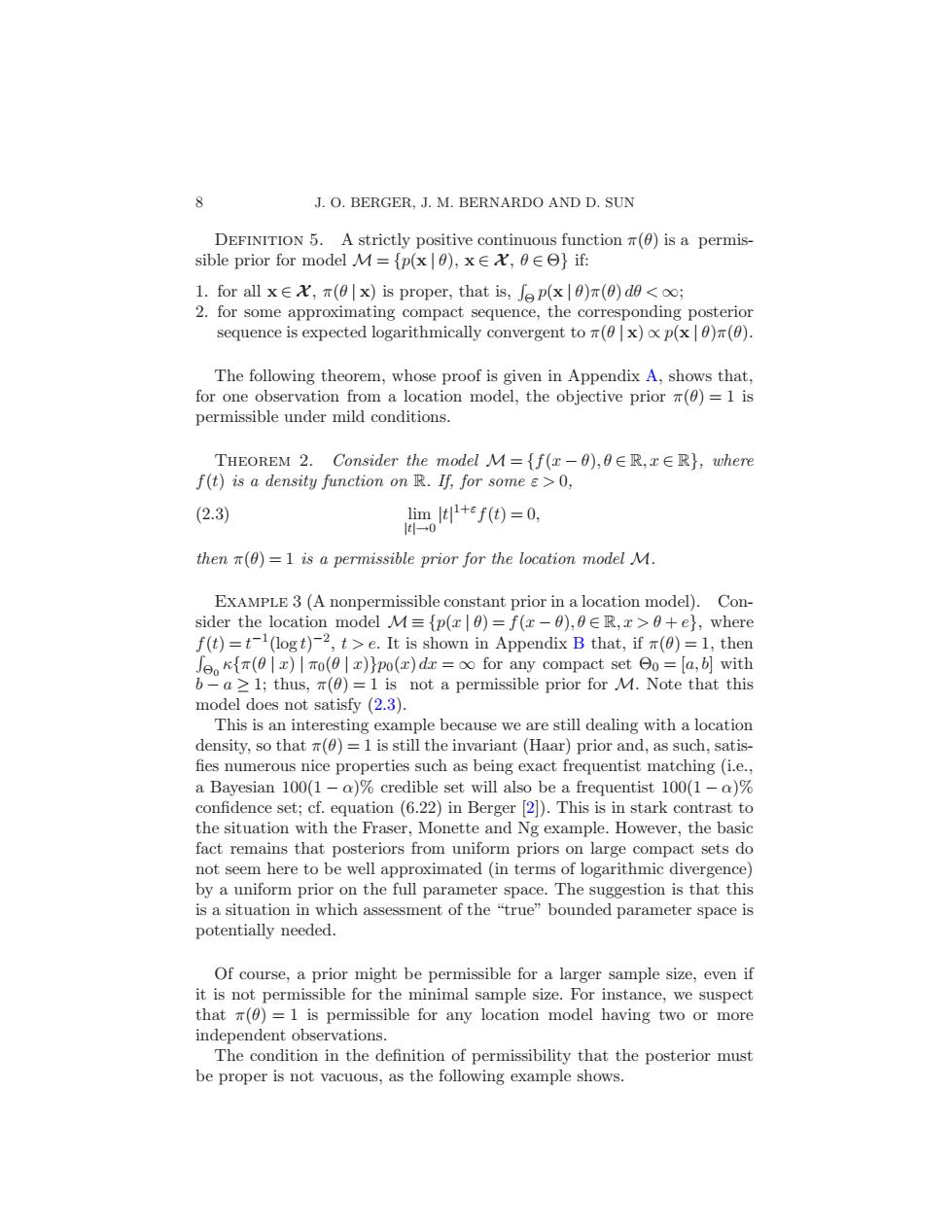正在加载图片...

J.O.BERGER.J.M.BERNARDO AND D.SUN DEFINITION 5.A strictly positive continuous function ()is a permis- sible prior for model M={p(x|0),x∈X,0∈Θ}if 1.for all xEX,x)is proper,that is,fe p(x)()de<oo; 2.for some approximating compact sequence,the corresponding posterior sequence is expected logarithmically convergent to r(x)o p(x)(0). The following theorem,whose proof is given in Appendix A,shows that, for one observation from a location model,the objective prior (0)=1 is permissible under mild conditions. THEOREM 2.Consider the model M={f(x-0),0ER,IER),where f(t)is a density function on R.If,for some >0, (2.3) lim tef(t)=0, t→0 then n(0)=1 is a permissible prior for the location model M. ExAMPLE 3(A nonpermissible constant prior in a location model).Con- sider the location model M=p(x0)=f(x-0),6ER,x>0+e},where f(t)=t-(logt)-2,t>e.It is shown in Appendix B that,if ()=1,then (I mo()}po()dz=oo for any compact set 0o=[a,b]with b-a >1;thus,n(0)=1 is not a permissible prior for M.Note that this model does not satisfy (2.3). This is an interesting example because we are still dealing with a location density,so that r()=1 is still the invariant (Haar)prior and,as such,satis- fies numerous nice properties such as being exact frequentist matching (i.e., a Bayesian 100(1-a)%credible set will also be a frequentist 100(1-a)% confidence set;cf.equation(6.22)in Berger [2]).This is in stark contrast to the situation with the Fraser,Monette and Ng example.However,the basic fact remains that posteriors from uniform priors on large compact sets do not seem here to be well approximated (in terms of logarithmic divergence) by a uniform prior on the full parameter space.The suggestion is that this is a situation in which assessment of the "true"bounded parameter space is potentially needed. Of course,a prior might be permissible for a larger sample size,even if it is not permissible for the minimal sample size.For instance,we suspect that m(0)=1 is permissible for any location model having two or more independent observations. The condition in the definition of permissibility that the posterior must be proper is not vacuous,as the following example shows.8 J. O. BERGER, J. M. BERNARDO AND D. SUN Definition 5. A strictly positive continuous function π(θ) is a permissible prior for model M = {p(x | θ), x ∈ X , θ ∈ Θ} if: 1. for all x ∈ X , π(θ | x) is proper, that is, R Θ p(x | θ)π(θ) dθ < ∞; 2. for some approximating compact sequence, the corresponding posterior sequence is expected logarithmically convergent to π(θ | x) ∝ p(x | θ)π(θ). The following theorem, whose proof is given in Appendix A, shows that, for one observation from a location model, the objective prior π(θ) = 1 is permissible under mild conditions. Theorem 2. Consider the model M = {f(x − θ),θ ∈ R,x ∈ R}, where f(t) is a density function on R. If, for some ε > 0, lim |t|→0 |t| 1+ε (2.3) f(t) = 0, then π(θ) = 1 is a permissible prior for the location model M. Example 3 (A nonpermissible constant prior in a location model). Consider the location model M ≡ {p(x | θ) = f(x − θ),θ ∈ R,x > θ + e}, where f(t) = t −1 (log t) −2 , t > e. It is shown in Appendix B that, if π(θ) = 1, then R Θ0 κ{π(θ | x) | π0(θ | x)}p0(x) dx = ∞ for any compact set Θ0 = [a,b] with b − a ≥ 1; thus, π(θ) = 1 is not a permissible prior for M. Note that this model does not satisfy (2.3). This is an interesting example because we are still dealing with a location density, so that π(θ) = 1 is still the invariant (Haar) prior and, as such, satis- fies numerous nice properties such as being exact frequentist matching (i.e., a Bayesian 100(1 − α)% credible set will also be a frequentist 100(1 − α)% confidence set; cf. equation (6.22) in Berger [2]). This is in stark contrast to the situation with the Fraser, Monette and Ng example. However, the basic fact remains that posteriors from uniform priors on large compact sets do not seem here to be well approximated (in terms of logarithmic divergence) by a uniform prior on the full parameter space. The suggestion is that this is a situation in which assessment of the “true” bounded parameter space is potentially needed. Of course, a prior might be permissible for a larger sample size, even if it is not permissible for the minimal sample size. For instance, we suspect that π(θ) = 1 is permissible for any location model having two or more independent observations. The condition in the definition of permissibility that the posterior must be proper is not vacuous, as the following example shows